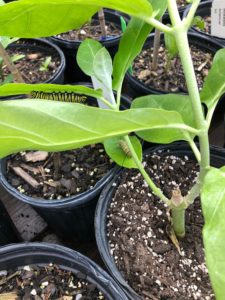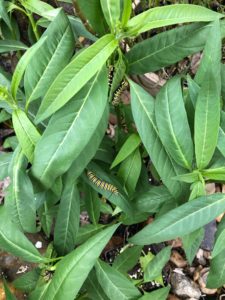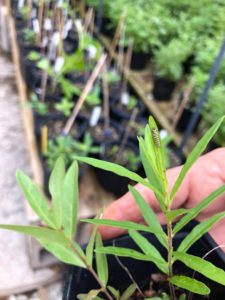They’re here! Our beloved butterfly and the state of Texas insect, the Monarch, began its trek to the north in early March from the Sierra Madre Mountains in Mexico. These are the Eastern North American Monarchs that fly up to 3,000 miles each fall to reach their destination in the Oyamel fir forests, with an elevation of 2,000 miles above sea level.
These forests provide the ideal temperature for the Monarchs to cluster together to stay warm and conserve their fat reserves. Once the temperatures start getting warmer, (60°F and higher) they begin to migrate northward, mate and look for milkweed on which to lay their eggs.
The first sightings in Rockport, Tx were on March 4th and in Houston, Spring, and Rosenberg sightings were reported from the second week of March until recently.

Monarch Caterpillar on Giant Milkweed, Calotropis gigantea at MCMGA Greenhouse, Texas A&M AgriLife Extension in Conroe
Monarch enthusiasts and Citizen Scientists alike were looking to replenish their milkweed as eggs hatched into voracious caterpillars that stripped the milkweed into bare stalks in a matter of days.
Milkweed is the only food they need to sustain each generation. All parts of the plant are toxic, however, the Monarchs have adapted to the toxins and use these to ward off most predators.

Monarch Caterpillars on Tropical Milkweed in the Bog at MCMGA, Texas A&M AgriLife Extension in Conroe
Texas has approximately thirty native species of milkweed, but the milkweed most often found in nurseries is a non-native Tropical (or Mexican) Milkweed, Asclepias currasavica – as it is the easiest milkweed to propagate.
Native milkweeds have a long taproot and resent being transplanted. Usually, it takes a couple of years to see a native milkweed reach any discernible height to serve as a meal for hungry caterpillars, so it takes patience. However, we should try to grow more native milkweed as it is an important food source for the Monarch caterpillar, offers diversity for the Monarch population, and is less prone to carry the OE disease that is fatal to the Monarch. Read more about this here:
https://www.wildflower.org/expert/show.php?id=11318
Following are but a few of the most popular native species:
Antelope Horns, Asclepias asperula – Mainly found in rocky and sandy prairies
Green Milkweed, Asclepias viridis – Normal habitat East Texas to Edwards Plateau

Tiny Caterpillar on Asclepias tuberosa at MCMGA Greenhouse at Texas A&M AgriLife Extension at Conroe
Butterfly Weed, Asclepias tuberosa – Found in prairies, post-oak savannas, Rolling Plains and many other areas in Texas
Whorled Milkweed – Asclepias verticillata – Coastal prairies and post oak savannas
Aquatic Milkweed – Asclepias perennis – Found at edges of swamps and moist bottom land
Swamp Milkweed – Asclepias incarnata – Grows in wet soils at the edge of streams and ponds
For more information on growing native milkweed from seed see the article from the Texas Butterfly Ranch
https://texasbutterflyranch.com/2013/03/13/how-to-get-texas-native-milkweed-seeds-to-germinate/